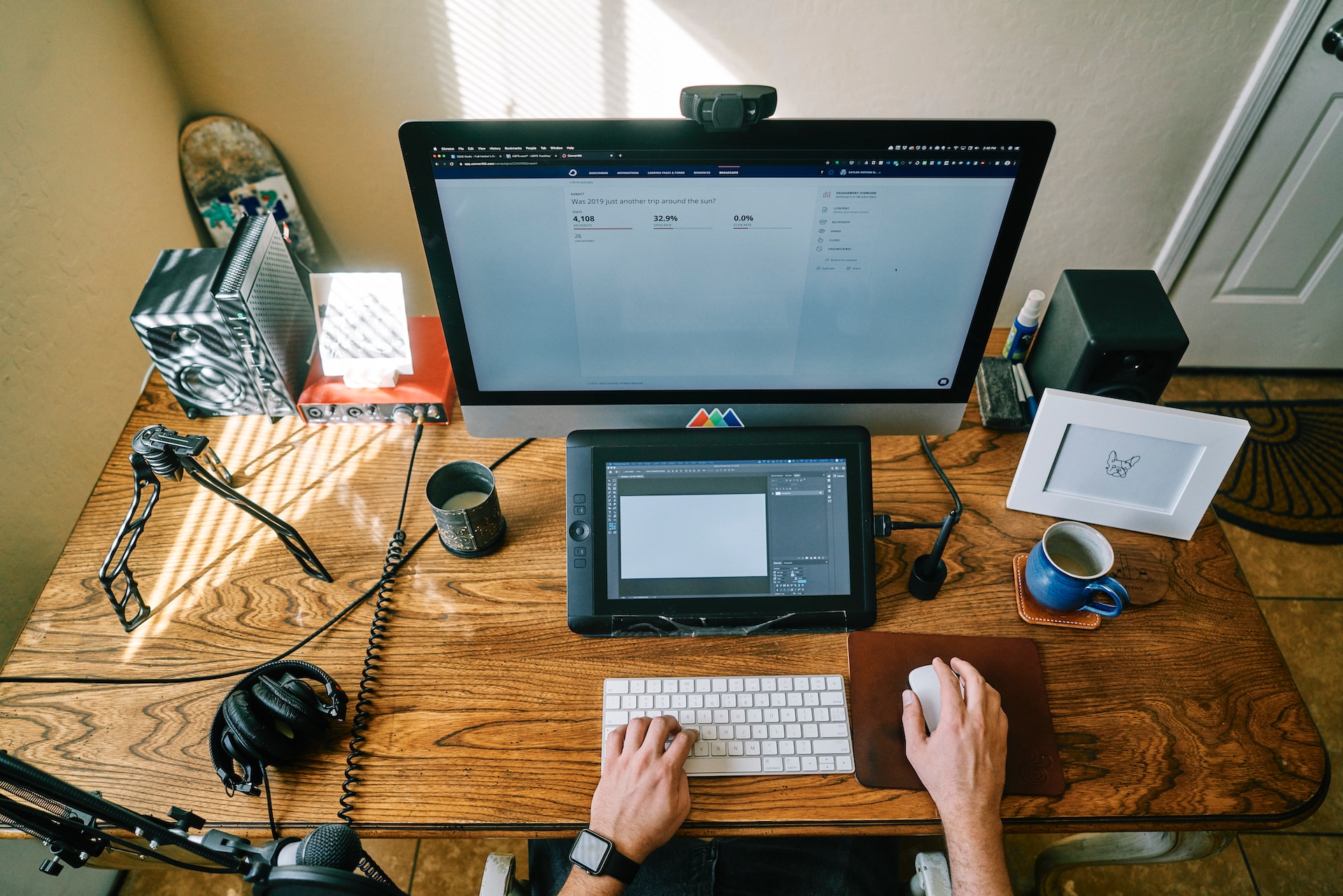Whether you’re a freelancer, business owner, virtual assistant, or direct employee, working from home is a fantastic way to avoid some common office headaches. You won’t have to sit in traffic every day, and there’s no more water cooler gossip and office drama to contend with. But working from home also presents unique challenges, especially if it’s new to you. Thankfully, with a few simple adjustments, you’ll be able to stay productive, happy and avoid fatigue while working remotely. So if you’re wondering how to maintain — or improve — your productivity at home, keep reading.
Designate a specific workspace
In order to maintain productivity, you really need to have a dedicated workspace. Whether it’s a spare bedroom, a spot over the garage, or a corner of the kitchen, it’s vital to set up a part of your home that’s solely to work. This will help you separate work from home, and it provides you with a comfortable, quiet place to work. Maybe you should consider investing in noise-canceling headphones if background noise is a problem at home.
Furnish the space with a comfortable office chair and a durable desk so it’s clear that this area is made just for working. Try an ergonomic chair. The average American works 8.8 hours daily, which is a long time to sit in an uncomfortable chair. An ergonomic desk chair can support good posture, decrease neck and back pain, and boost job performance.
Customize your workspace with art or pictures and all of the supplies and tools you need for a productive workday. Placing family, friends, or treasured memory images can increase your attitude.
Create a productive atmosphere
In order to stay productive while working from home, you’ll need to create an atmosphere that fosters productivity. If you enjoy classical music to help you focus, bring in a small stereo or wireless speaker. Keep your office supplies and files nearby and handy so you don’t have to keep wandering around the house to find what you need. Ensure that your desk chair is comfortable and supportive for better posture. Check out this article about the 7 habits of highly productive people for more tips.
The physical environment and working circumstances of your workplace influence your productivity. It could be time to give your office a much-needed makeover, if not a facelift. Here are some of the greatest areas to concentrate your efforts:
- Allow as much natural light in as possible. Natural light boosts Vitamin D absorption and improves mood. You can reap these benefits by moving your home office near a window. Also, position your computer in front of or near a window to avoid glare.
- Choose the appropriate colors for your office. Yellow, for example, is good for creativity, whilst muted colors are restful and comforting.
- Placed houseplants throughout your home office. WeWork says employees are more productive when surrounded by office plants. So adding a plant to your desk might boost productivity.
- Maintain a temperature of 72 degrees.
- Install an air freshener.
- Make an ergonomic workplace design to avoid carpal tunnel syndrome and eye strain.
Invest in the tools you need for remote work

Whether it’s a new laptop, a better Internet package, a comfortable headset, or a decent filing cabinet, finding the best remote working tools that both employees and the business benefit from are just part of the work; having the right tools will make remote working easier. People working remotely, regardless of location, can benefit from remote working software. Communication and networking technologies such as video chat applications or messaging tools, cloud storage, task and project management systems, and remote team management apps are examples of remote working software. Look for new technology and creative office products that can help make working from home more pleasant and productive.
If you are looking to improve your productivity, using project management systems can be a great way to do so. These tools can help you manage your time, prioritize tasks, and stay organized. They can also help you increase your productivity by providing you with reminders and tracking your progress.
A standing desks help posture and lower back pain. Your chair, or lack thereof, can also significantly affect your workstation. For example, an ergonomic standing desk can enhance energy, keep you interested, and improve phone communication. Standing while working increases daily activity, which has health benefits. Moderation is vital in all changes. The greatest work-from-home solution is alternating between sitting and standing using a standing/sitting desk. Browse our laptop stands and standing desks.
Ask if your company will reimburse you for some or all of your work-from-home tools. Employers are now realizing that the home office can actually help productivity and with advanced technology, it has never been this simple to set up a professional working environment at home that empowers efficiency. Be mindful of all the challenges that WHF workers face.
Start early and establish a morning routine
It’s really tempting to hit the snooze button when you work from home, but sleeping in can backfire. Do your best to start your day as early as possible so you can stay on top of your game. If you used to get up at 5:30 a.m. to head to work, keep doing so while you’re working from home. Starting your day early gives you time to wake up, have some coffee, relax a little, and align your mindset with the tasks ahead. Establish a morning routine as soon as possible so that it becomes a natural way to transition from “home” mode to “work” mode.
Consciously integrating practices to prevent burnout into your daily routine is crucial, especially when the boundaries between personal and professional life can blur while working from home. One effective strategy is to integrate mindful breaks throughout your workday. This could involve stepping away from your workstation to indulge in a brief walk, practicing mindful breathing, or engaging in a short meditation session. These moments of pause are not merely breaks but rejuvenation periods that enable mental and physical recuperation. It’s essential to remember that maintaining a healthy work-life balance isn’t just beneficial on a personal level; it also enhances your overall productivity and the quality of your work. Therefore, be deliberate about allotting time for rest and relaxation to safeguard your well-being and sustain your professional performance.
Pretend you’re going into the office
Even though you don’t need to dress up and make the drive to the office, it’s a good idea to pretend as you do. Even though you’re allowed to work in your pajamas at home, getting dressed can boost productivity and put you in a more professional, productive mindset. You don’t have to put on a suit and tie but slip on some actual pants you’d wear to the grocery store and a shirt that makes you look somewhat presentable on Zoom. This one simple act of changing into “work” clothes will help you remember that it’s during office hours, and you need to work.
Stick to a schedule

Keep your workday at home as close to the same as it would be if you were in the office. The problem now is to figure out how to adapt to working from home in a home office, and possibly even working at home with your partner. By structuring your day, you’ll be more productive and stay on track with projects and deadlines. Make your work-from-home day feel like a work-from-the-office day with a daily set schedule. Start and end your office hours and take your lunch at the same time each day.
Use a calendar program or a dry erase board to keep your schedule handy. Set reminders for breaks and lunch. One of the most typical blunders for people who start working from home is having no timetable at all. Sticking to a schedule helps you stay on task and avoid wasting time. Consider a time tracker to help you stay on top of your hours and what you’re accomplishing each day. Establish some techniques to sharpen your time management skills. Check out this site for daily free schedule templates.
Establish daily goals
It’s important to set daily goals for yourself. This is beneficial not just to your boss and your company, but also to you, since writing down your goals helps you meet them and manage your time. Each morning before you start working, write down one goal you’d like to accomplish and the individual tasks necessary to do it. This simple step will help you stay focused on the most important things on your plate each day.
Take movement breaks
Since you’re not in the office, you may tend to sit at your home desk for longer periods at a time than you normally would — and we all know that sitting is the new smoking. Take hourly breaks for your mental and physical well-being to break up the monotony of working from home. Get up, move your body, stretch your muscles, drink a glass of water. A couple of times a day, if you can, take a brisk walk around the block, or do five or 10 minutes on the treadmill to help clear and energize your body and mind. On top of your movement breaks, schedule in a couple of 10- or 15-minute breaks to toss some clothes in the wash, take a power nap or check your social media. Set an alarm to tell you when break time is over.
Save calls for the afternoon

If you talk to clients, coworkers, or customers on the phone, try to save these calls for the afternoon. This frees up your morning to focus on other tasks uninterrupted, which is essential for staying on track. If your company shares calendars, mark your mornings off on yours so that other people don’t book morning meetings with you. If you focus better in the afternoons and prefer making your calls in the morning, that works, too! Don’t forget to keep track of your email response time to boost your productivity. You can also send out meeting reminders via WhatsApp using TimeSync no avoid no-shows and reduce stress on your workday, check out this article to find out more about this tool.
Listen to music
Not everyone can work and listen to music at the same time. However, if you find that music helps you stay focused, feel free to put on some tunes. You can use a pair of high-quality headphones to help you immerse yourself in the music and the job at hand, or play music from your wireless speaker or smart speaker. If your usual favorite music is too distracting, put on some classical or New Age music, which is more atmospheric background noise. Many people find that music reduces stress and helps with focus, so it’s worth giving it a try.
Limit distractions: Block social media during work hours
The Internet is a very distracting place and can lead to a major drop in productivity. If you have a home phone, turn the ringer off during the day, and turn off notifications on your mobile device. Use a browser plug-in or mobile app to block social media, news channels, and other distracting sites during work hours. Avoid turning on the TV or chatting with friends until your workday is completely over. These simple things will help create the right atmosphere and avoid distractions for staying on task.
Set boundaries with your family

If you have projects or important tasks that require your complete attention, the last thing you need is to be constantly interrupted by family members who are also at home. Set clear boundaries and expectations with them, such as when your office door is closed, you’re unavailable, or you can’t be disturbed between one and four in the afternoon. Have snacks handy that the kids can get on their own, and before you shut your door to hunker down, ask everyone if they need anything before you go away.
Keep in touch with your colleagues
When you work from home, it’s easy to feel isolated and even a little bit lonely at times. Make sure to keep in touch with your colleagues each day to maintain a sense of workplace culture, teamwork, and friendship. Use a group chat program to stay connected. Check-in periodically for water-cooler conversations, funny memes, or other short bursts of human interaction so you don’t feel isolated.
Also, try to incorporate team-building activities, as they give employees the option to create problem-solving techniques. The best Notion widgets make it easy for teams to bond over virtual events such as online games or movie nights, helping them stay connected while working remotely.
When it’s time to stop working, stop
It’s easy to work well beyond your usual hours when you’re working from home, but it’s important to call it a day for several reasons. Working late while at home can make you feel like you never get a break, and your family may feel like you’re always working. It also means that, unless you’re on salary, you’re working those extra minutes and hours for free, and that can lead to feelings of resentment later on.
Each day, work the number of hours you get paid for. If you’re not on salary and expected to be available after hours, let your boss and co-workers know that after, say, five o’clock, you’re out of the office until morning. Then, close your computer, turn off notifications, and change into your relaxing clothes to signal that it’s time to shut off your work brain. Spend a half-hour after work practicing some self-care, like taking a nice hot bubble bath, a short nap, or simply vegging in front of the TV.
Keep healthy habits

While the right mindset is important for productivity while working from home, so is maintaining your physical health. Start every day with a healthy breakfast to fuel your mind and body in the hours ahead. Each weekend, plan your snacks and lunches for the week ahead and have everything on hand and ready to go so you don’t end up eating unhealthy food just to put something in your stomach. Drink plenty of water throughout the day, and try to limit your coffee to a couple of cups — a bottomless pot may give you jitters and make it hard to sleep. If you want to stay focused without the caffeine, you can look into high-quality nootropic supplements. Take all of your movement breaks each day, and when you feel stressed, take a few minutes for some deep breathing or meditation.
Declutter and stay organized throughout the day
A cluttered office can really throw you off-focused. It can also make you feel stressed and overwhelmed. Make sure your home office is nicely organized, and try to keep it that way throughout the day. The more organized your environment is, the easier it will be to get things done quickly. A neat, tidy office can also lower your stress levels, too. Each morning, get organized with the files and tools you need for the day. Put away anything left out from the day before that you don’t need. At the end of the day, put your pens away, discard trash, take your dishes to the kitchen, and tidy up your workspace.
Stay aligned with the Company’s Culture
Even when you’re working from home, a few simple techniques might make you feel as though you’re at the office. Maintain your current behavior in accordance with the culture of your company. Working from home undoubtedly alters the experience. We commonly lose touch with the work-self that used to commute every day and be active.
We tend to overlook the tiny elements of our office days because we spend so much time at home these days. For instance, sending jokes and memes, talking about family or sports while waiting for coffee, or sending emails or texts with company-related GIFs. Additionally, volunteering for an event is increasingly done online. So keep doing these things from home to give yourself a work atmosphere.
Hybrid work environment
All businesses were obliged to move work from the office to the home as a result of the pandemic. Additionally, the staff is now used to working remotely. Everyone felt secure in their decision to work from home. However, individuals are being called back to work as soon as the offices reopen. And not everyone agrees with this.
Businesses are using the hybrid work paradigm as a result. But what precisely does a mixed work model entail? It alludes to the workplace culture where employers give workers the option of working from home or an office. In other words, a hybrid strategy will enable employees to work from home some of the time and in an office the rest of the time.
The hybrid idea is not new, but it is growing in acceptance as the professional environment has changed recently. Additionally, more tasks that can be done from home are emerging, giving the hybrid work culture flexibility. The goal is to boost workforce productivity, and performance and maximize staff efficiency.
Employee energy levels are sure to remain high in a hybrid work environment because they won’t be drained and frustrated by traveling to and from work.
Home Insurance and Coverage for Home Office Equipment
Home insurance policies typically provide coverage for personal belongings, including home office equipment, up to a certain limit and under specific circumstances. However, the extent of coverage can vary based on the type of policy you have and the specifics of your situation. Here are some key points to consider:
Standard Coverage: Most home insurance policies provide coverage for personal belongings, which can include home office equipment such as computers, printers, furniture, and other items. These items are usually covered under the policy’s personal property coverage.
Coverage Limits: There is often a limit to the amount of coverage provided for personal property. This limit may be a percentage of your overall dwelling coverage, which is the amount of insurance you have on the structure of your home. Make sure to check your policy’s limits to ensure they adequately cover your home office equipment.
Special Limits: Some policies might have special limits on certain types of property, like electronics or business-related equipment. These limits could be lower than the general personal property coverage limits. It’s important to understand these limits and assess whether they meet your needs.
Business-Related Equipment: If you use your home office for business purposes, the coverage for your business-related equipment might be limited or excluded under a standard homeowners policy. In such cases, you may need to consider a separate business insurance policy, like a home-based business insurance or an in-home business policy, to adequately cover your business assets.
Deductibles: Keep in mind that you’ll typically have to pay a deductible before your insurance coverage kicks in. Make sure the deductible amount aligns with what you’re comfortable paying out of pocket in case of a claim.
Coverage for Perils: Home insurance policies usually cover a range of perils, such as fire, theft, and certain types of water damage. Make sure to review your policy’s list of covered perils to understand what situations are eligible for coverage.
Documentation: To make the claims process smoother, it’s a good practice to keep an inventory of your home office equipment, including receipts, photos, and other documentation that shows the value and condition of the items.
Given the potential complexities involved in insuring home office equipment, it’s advisable to consult with your insurance provider to discuss your specific needs. They can help you understand your policy’s coverage limits and exclusions, and they can also provide guidance on whether additional coverage, such as a business insurance policy, might be necessary to adequately protect your home office assets.
Final thoughts
For many, working from home is a dream come true, but it can quickly turn into a nightmare if you don’t manage your time properly or you get off task easily. The more effort you put into creating a productive space, cultivating the right mindset, compiling the tools you need, and staying on schedule, the more enjoyable and fulfilling your work-at-home experience will be.
If you approach it carefully, working from home has its benefits and isn’t entirely negative. Everyday commuters experience physical and mental tiredness, making it difficult for them to engage in other activities most of the time. However, working from home relieves us of this weariness.
You can follow your passion while maintaining a healthy work-life balance by working from home. Go for it if you enjoy baking or cooking. Spend time doing the things you enjoy. Every day after work, if you like to play the guitar, you can do so by picking out amusing songs or anything else that grabs your attention. However, it might be challenging to find the time and energy to bake or cook at home when you work a full-time job in an office.
Whether you’re working remotely temporarily or for the foreseeable future, you’ll get to enjoy the benefits of having a work-from-home job, but not having to leave your house to do it. Check out his survey with 10+ thoughts on working from home vs. work from the office.




